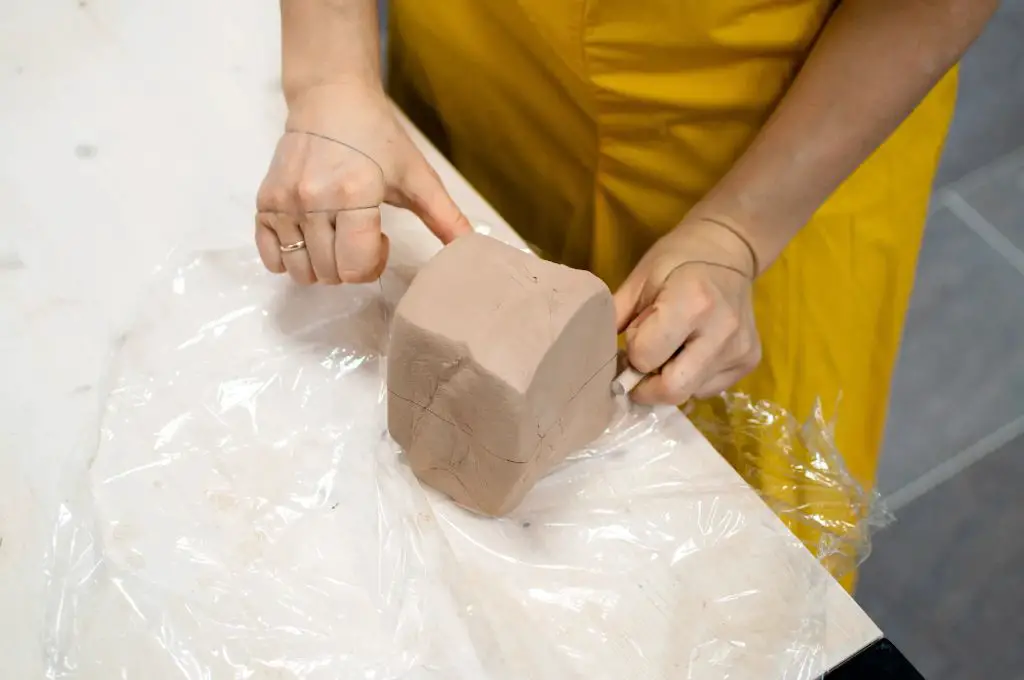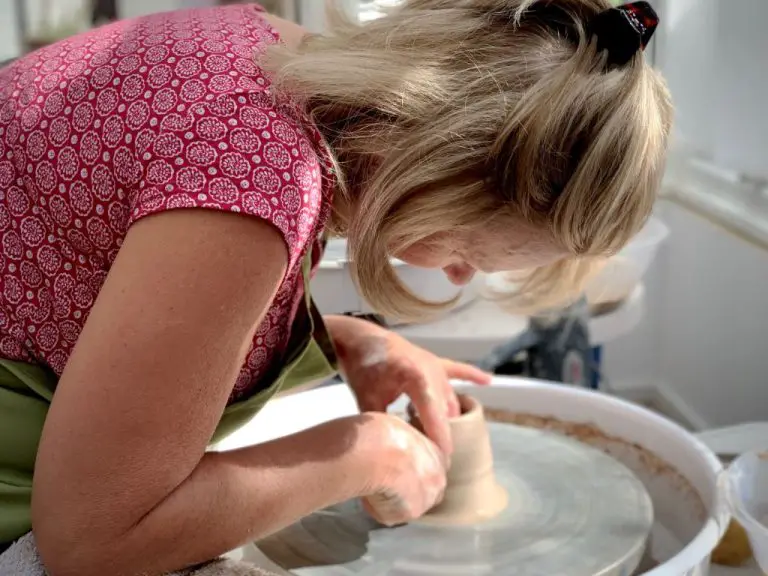Clay Pottery Slab-Building Techniques: Creating Structure
Slab building is a hand building technique in pottery and ceramics where clay slabs are rolled out and then joined together to form a three-dimensional structure. The earliest evidence of slab-built pots dates back around 18,000 years, with examples found in prehistoric sites around the world, including Mesoamerica [1].
Compared to other handbuilding techniques like coil building, slab building allows for greater precision and control in shaping ceramic forms. Slabs can be cut and joined in countless ways to create both functional pots and sculptural works. Key benefits of slab building include the ability to produce uniform thickness, assemble flat planes and straight walls, and create well-balanced forms with good structural integrity. Challenges can involve controlling warp and shrinkage, joining slabs smoothly, and avoiding cracks and breakage.
Tools Needed
When working with clay slabs, having the right tools makes the process much easier. Here are some of the essential tools for slab building:
Clay Slab Roller
A slab roller allows you to quickly and evenly roll out clay into slabs of a consistent thickness. Slabs rolled out by hand can be uneven and difficult to work with. Investing in a tabletop or freestanding slab roller saves time and effort.
Cutting Wires
Cutting wires are essential for cleanly cutting slabs and shapes. The wires are tightened across a frame to create tension that slices smoothly through the clay. Cutting wires come in various thicknesses for both coarse and fine cuts.
Ribs
Ribs are rigid tools used to compress and smooth clay surfaces. They come in metal and wood varieties, with different shapes for contouring slabs. Ribs give you control and help remove air pockets.
Fettling Knives
Fettling knives have a curved blade to trim excess clay from slab edges. The flexibility allows for both rough cutting and smoothing finished edges.
Sculpting Tools
Loop tools, ribs, and various shaped tips can be used to add contours and textures to slab built pieces. Consider having a set of sculpting tools on hand for creative detailing.
Preparing the Clay
Properly preparing the clay is an essential first step in slab building. Begin by wedging the clay to remove air bubbles and evenly distribute moisture. Knead and compress the clay on a wedging table until it has a uniform consistency. Pay attention to the clay’s plasticity and stiffness as you wedge – the clay should be soft enough to bend without cracking, but firm enough to hold its shape when rolled into a slab.[1]
Consider how much shrinkage to expect with your clay body and the thickness of the slabs you’ll be using. A thicker slab will shrink less than a thinner one. The intended size of your finished piece will determine the thickness you roll the slabs to. Aim for even thickness across all your slabs so drying happens at the same rate.
Remove any large air pockets or debris before rolling out the clay. Use a rib tool, knife or fettling knife to cut into bubbles and smooth them out. Having a homogeneous clay mixture is key for avoiding cracks and breakage once your piece is assembled.
Rolling Out Slabs
The key to creating even, uniform slabs of clay is using a rolling pin or slab roller. Slab rollers are specialized tools designed specifically for rolling clay, while rolling pins found in most kitchens can also be used.
When using a rolling pin, it’s important to have a flat, smooth, and nonporous surface to roll on. Granite, marble, plexiglass sheets, and MDF boards all work well. You’ll also want to use rolling pin guides – these can be made by attaching two pieces of wood or PVC pipes parallel to each other on the rolling surface. The gap between them should be slightly wider than your desired slab thickness.
Dust the surface and clay lightly with cornstarch or talc powder before rolling. This prevents the clay from sticking. Place the clay between the guides and roll back and forth, turning the clay 90 degrees after every few passes. Check thickness frequently with a ruler. The clay should maintain an even thickness once rolled out.[1]

Slab rollers take the difficulty out of rolling consistent slabs. Simply pass the clay through the rollers to achieve the desired thickness. Adjust the roller spacing for thinner or thicker slabs. Keep dusting with powder to prevent sticking. Roll in only one direction, and avoid back-and-forth rolling which can distort the clay shape.
Cutting and Smoothing Slabs
Cutting slabs to the desired shape and size is an important step in slab building. Most potters use cutting wires for this task. Cutting wires are thin, taut wires that allow you to slice cleanly through clay slabs. Stainless steel cutting wires work best for pottery. Before cutting, score the slab lightly along the desired cut line using a needle tool or craft knife so the wire doesn’t drag the clay. Hold the wire taut and guide it evenly through the clay to create a straight, clean cut. Rest the slab on foam or a soft surface when cutting to avoid damaging the work surface.
After cutting, you may want to smooth and refine the slab edges. Beveling the edges at a 45 degree angle with a rib or metal kidney tool creates nice clean seams when joining. Ribs are also great for gently smoothing away rough edges and excess clay where the wire cut through. For smooth rounded edges, consider using an upside down tapered wine glass as mentioned in this Reddit comment: “What’s your favorite unconventional pottery tool?”. Work slowly and gently when handling slabs at this delicate stage.
Joining Slabs
One of the most important skills in slab building is properly joining the individual slabs together to create a cohesive form. There are a few key techniques for getting a strong bond between slabs:
Scoring and slipping – Use a knife or needle tool to score or scratch grooves along the edges of the slabs you want to join. This helps the slurry adhere better. Apply watered-down clay slurry (liquid clay) to the scored edges and press the slabs together.Watch this video for a great visual demonstration of scoring and slipping.
Compressing seams – Once your slabs are joined, use your fingers, a rib, or a roller tool to compress the seams. This blends the clay together and creates a smooth transition between the pieces.
Avoiding cracks – Go slowly when joining slabs and let them dry slightly before moving them. Overworking the clay can lead to cracks. Also beware of joining slabs that are too wet or too dry.
Proper joining is crucial for building slab pieces that have the strength to hold together during drying, firing, and beyond. Mastering scoring, slipping, compressing, and careful handling will help your slab constructions maintain structural integrity from start to finish.
Shaping the Structure
When joining clay slabs together, you can create a variety of structural shapes like cylinders, boxes, and sculptural forms. The key is cutting and joining the slabs at proper angles.
For a basic cylinder shape, cut two longer rectangular slabs for the sides and two circular slabs for the top and bottom. Stand the side slabs upright and join the top and bottom slabs to create the cylindrical form. Smooth the seams from the inside using a rubber rib or kidney tool. For more complex shapes, cut angled edges on the slabs before joining to create facets and dimensions.
Square and rectangular boxes can be constructed in a similar fashion by cutting four rectangular slab “walls” and joining them at right angles. Cut one slab for the bottom and create a lid by cutting a matching sized slab for the top. Again, blend the seams from the inside with clay tools.
With thoughtful planning, clay slabs can be cut and joined in creative ways to make abstract sculptural forms. Consider the overall shape and structural integrity as you cut angles and curves for the slabs. Let the clay slabs guide you to an interesting three-dimensional form.
For shaping and joining tips, see this excellent tutorial: Basics of Hand-Building Slab Pottery
Texturing Slabs
Texturing clay slabs can add visual interest and dimension to a slab-built piece. There are many techniques for texturing slabs including incising, imprinting, and using molds.
Incising involves carving into the surface of the slab using various tools like knifes, forks, or even combs. This allows you to create patterns by scratching the surface. For incising, make sure the clay is leather-hard. Use various tools at different angles to create unique designs.
Imprinting involves pressing objects into the surface of the slab to leave an impression. Items like leaves, lace, burlap can be used. Press the object gently into the clay, being careful not to tear the slab. Imprinting works best when the clay is still soft.
Clay slabs can also be textured using molds. Press the slab into the mold to pick up the design. Molds can be purchased or handmade from plaster, wood, or clay. Be sure to dust the mold with talc powder so the slab releases easily.
Experimenting with different texturing techniques allows endless options for adding interest to slab-built vessels and structures. The textures will remain visible even after glazing.
For more on texturing clay slabs, check out this video: Hand building a wrap around mug and textured clay slabs.
Drying and Firing
After slabs have been assembled and shaped, they must be thoroughly dried before firing according to the proper procedures. Even drying is crucial to prevent cracking and warping. Place pieces in a warm, dry area out of direct sunlight. Use fans to circulate air around the pieces. Drying times can range from a few days for smaller pieces to weeks for larger, thicker pieces.
Before firing, a bisque firing is recommended to slowly bring the clay up to an intermediate temperature. This toughens the clay and prepares it for glazing if desired. During bisque firing, ramp up the kiln temperature slowly, around 200°F per hour. Hold the maximum temperature (usually around cone 04) for 2 hours before cooling. Then pieces are ready for a final glaze firing if glazing, or can be left unglazed.
Tips and Tricks
Clay slab building allows for immense creativity, but there are some helpful tips to avoid pitfalls and make the process easier. First, always score and slip joins between slabs to get a secure connection (source). Don’t join slabs that are too wet or dry. Let slabs sit at room temperature before joining. When texturing slabs, imprinting objects work better on stiffer clay versus softer. If slabs begin drying and cracking, spritz water and cover in plastic wrap (source).
A great finishing technique is to carve decorative lines into leather-hard clay with wooden or metal tools. To achieve clean joins between slabs, smooth edges by rubbing with a metal rib. For pieces with multiple slab-built components, use slip to attach parts after bisque firing. When constructing forms, cut angled shapes rather than square joints for smoother lines. Let gravity help shape curved forms as you build. Start with thicker slabs on the bottom and taper walls upwards.
Some design hacks include cutting shapes like circles out of slabs for ornamental features on pots. Cut slab outlines first, then remove excess clay. Build vertical walls by joining and overlapping slabs. Add textures with stamps, rollers, or found objects before further shaping. Let your imagination run wild with the many possibilities of slab construction!

